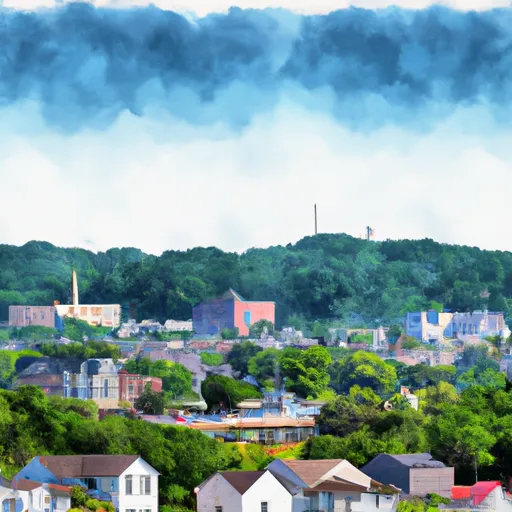-
 Snoflo Premium
Snoflo Premium
Get unlimited access to all our content
With no Ad interruptions! - Start Your Free Trial Login with existing account
Hollywood
Eden Index
Climate
9.8
•
Recreation
4.2
•
Community
1.6
•
Safeguard
5.8/10

Hollywood, Maryland is a charming town located in St. Mary's County. The climate in Hollywood is classified as a humid subtropical climate, characterized by hot summers and mild winters. The average high temperature in summer ranges from 85-90°F, while winter temperatures average around 40-50°F. The area experiences moderate rainfall throughout the year.
Hollywood is surrounded by several water bodies, including the Patuxent River and its tributaries. These hydrology constituents provide opportunities for various recreational activities such as boating, kayaking, fishing, and swimming. The serene waterways also allow for breathtaking views and peaceful walks along the shores.
In addition to water-based activities, Hollywood offers a range of outdoor recreation opportunities. The area is home to several parks and nature reserves, such as the Greenwell State Park and Myrtle Point Park. These areas provide hiking trails, picnic spots, and camping facilities, allowing visitors to enjoy the natural beauty of the region. Hollywood's proximity to the Chesapeake Bay also offers opportunities for birdwatching, wildlife spotting, and exploring the diverse ecosystems.
Overall, Hollywood, Maryland offers a favorable climate, beautiful hydrology constituents, and a plethora of outdoor recreation opportunities that cater to nature enthusiasts and adventure seekers alike.
What is the Eden Index?
The Snoflo Eden Index serves as a comprehensive rating system for regions, evaluating their desirability through a holistic assessment of climate health, outdoor recreation opportunities, and natural disaster risk, acknowledging the profound impact of these factors on livability and well-being.
Climate Health Indicator (CHI): 9.8
Hollywood receives approximately
1158mm of rain per year,
with humidity levels near 76%
and air temperatures averaging around
14°C.
Hollywood has a plant hardyness factor of
7, meaning
plants and agriculture in this region tend to thrive during the non-winter months.
By considering the ideal temperature range, reliable water supplies, clean air, and stable seasonal rain or snowpacks, the Climate Health Indicator (CHI) underscores the significance of a healthy climate as the foundation for quality living.
A healthy climate is paramount for ensuring a high quality of life and livability in a region, fostering both physical well-being and environmental harmony. This can be characterized by ideal temperatures, reliable access to water supplies, clean air, and consistent seasonal rain or snowpacks.
Weather Forecast
Streamflow Conditions
Upper Chesapeake
Area Rivers
Upper Chesapeake
Snowpack Depths
Upper Chesapeake
Reservoir Storage Capacity
Upper Chesapeake
Groundwater Levels
Recreational Opportunity Index (ROI): 4.2
The Recreational Opportunity Index (ROI) recognizes the value of outdoor recreational options, such as parks, hiking trails, camping sites, and fishing spots, while acknowledging that climate plays a pivotal role in ensuring the comfort and consistency of these experiences.
Access to outdoor recreational opportunities, encompassing activities such as parks, hiking, camping, and fishing, is crucial for overall well-being, and the climate plays a pivotal role in enabling and enhancing these experiences, ensuring that individuals can engage in nature-based activities comfortably and consistently.
Camping Areas
| Campground | Campsites | Reservations | Toilets | Showers | Elevation |
|---|---|---|---|---|---|
| Point Lookout State Park | 143 | 2 ft | |||
| Belle Isle State Park | None | 12 ft |
Nearby Ski Areas
Catastrophe Safeguard Index (CSI):
The Catastrophe Safeguard Index (CSI) recognizes that natural disaster risk, encompassing floods, fires, hurricanes, and tornadoes, can drastically affect safety and the overall appeal of an area.
The level of natural disaster risk in a region significantly affects safety and the overall livability, with climate change amplifying these risks by potentially increasing the frequency and intensity of events like floods, fires, hurricanes, and tornadoes, thereby posing substantial challenges to community resilience and well-being.
Community Resilience Indicator (CRI): 1.6
The Community Resilience Indicator (CRI) recognizes that education, healthcare, and socioeconomics are crucial to the well-being of a region. The CRI acknowledges the profound impact of these elements on residents' overall quality of life. By evaluating educational resources, healthcare accessibility, and economic inclusivity, the index captures the essential aspects that contribute to a thriving community, fostering resident satisfaction, equity, and social cohesion.

